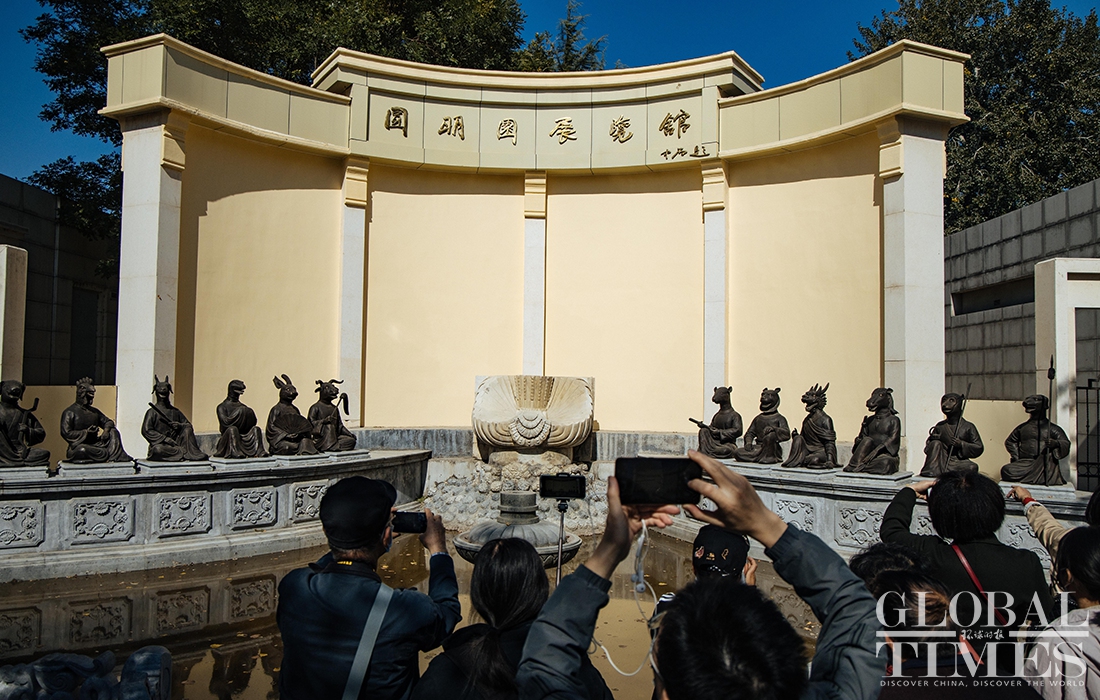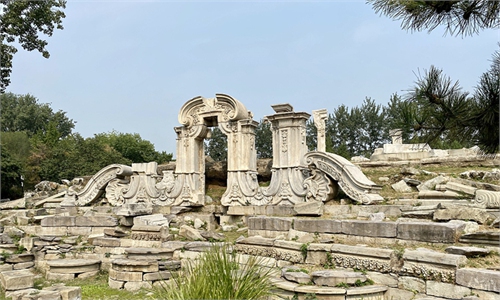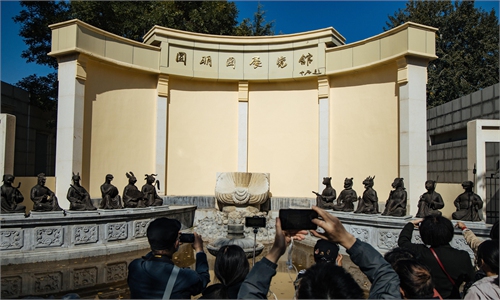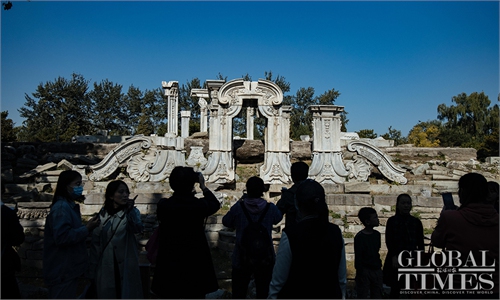Sack of Old Summer Palace commemorated in China
History of humiliation sparks debate on whether to keep ruins
The Old Summer Palace, or the Yuanmingyuan Ruins Park, in Beijing opened free of charge on Sunday to commemorate the 160th anniversary of the massive looting and destruction of the palace carried out by the Anglo-French Alliance Forces in 1860. The troops were sent by the British and French empires to invade China in the late Qing Dynasty during the Second Opium War (1856-60).
At present, Chinese people are debating whether the country should completely rebuild the palace or not, as experts note that this kind of debate has showed the two aspects of Chinese people's view of history - on the one hand, they want to keep the ruins to remind future generations about the consequences of being weak, poor and conceited; on the other hand, people want to restore the glorious and magnificent achievements that their ancestors gained hundreds of years ago, and to declare the success of the great rejuvenation of the Chinese nation.
Tens of thousands of tourists came to the park for sightseeing and to attend the commemoration on Sunday. Some parents and teachers brought children for patriotic and historical education so the young generation could learn what the foreign imperial forces did to ruin China when the country was weak and how they did it, while emphasizing that China today will no longer be bullied or invaded by any foreign force or superpower.
"I came here especially for the 160th anniversary of the mass looting. We should remember how horrible the disaster was that our country and its people suffered in the past. Now our country is very powerful so we can enjoy peace and prosperity. Through commemorating our national humiliation, we will treasure more the life we have today," a young lawyer surnamed Dong, 28, told the Global Times at the park.
A 25-year-old art teacher surnamed Liu who took her students to the scenic spot for a painting activity told the Global Times that she hopes her students can look at this history with awe, and know that the ruins of the Old Summer Palace are not just some stones laying around a park, but relics that have a profound meaning.
The hashtag "160th anniversary of the sacking of the Old Summer Palace" had earned 330 million views on China's Twitter-like Sina Weibo as of Sunday afternoon, with many Chinese netizens commenting: "Do not forget this humiliation of our nation."
National humiliation
The massive looting of the Old Summer Palace is a well-known historic event among Chinese people as it is a symbol of how corrupt, weak and cowardly the country was when it was under the rule the Qing Dynasty (1644-1911) in the middle of the 19th century. It reflects how Western imperialists and big colonial powers invaded, plundered and damaged China barbarically.
Covering more than 3.5 square kilometers, the palace was built in 1707 during the reign of the Kangxi Emperor. Qing emperors used it as an imperial garden to relax during the capital's hot summers. It is renowned throughout the world for its grand and elegant landscapes, extensive collection of gardens, architecture, art and historical treasures, according to reports.
On October 18, 1860, the Anglo-French Alliance Forces sacked and looted the palace during the Second Opium War. It took 4,000 looters three days to raze it to the ground. As they carried out their destruction, a large number of valuable cultural relics were taken overseas.
According to UNESCO, about 1.6 million Chinese relics are in the possession of 47 museums worldwide, including 1 million from the Old Summer Palace alone, media reported.
It is not only Chinese who view the incident as a barbaric crime, many foreign observers also share this opinion. In his "Expédition de Chine," French writer Victor Hugo (1802-1885) described the looting as "Two robbers breaking into a museum. One has looted, the other has burned… they came back to Europe laughing hand-in-hand." In his letter, Hugo hoped that one day France would feel guilty and return what it had plundered from China. The letter is included in the textbook for Chinese elementary schools.
Chinese analysts said that due to the current tensions between China and some Western countries, especially the US and some of its allies, the danger of war has become a concern among some Chinese people, who feel that some Westerners still hold extreme hostility against China even 160 years after the palace was looted. If the People's Republic of China were as weak as the Qing Dynasty, the US might not be hesitant to launch a real war to crack down on the rising China, the analysts noted.
"Chinese people have always reminded themselves of the humiliation and tragic memories of the past, so they will be motivated to put more efforts into making the country as powerful as possible, and keep vigilant to deal with the challenges today," Zhang Yiwu, a professor from Peking University, told the Global Times on Sunday.
Rebuild or remain
Experts studying the Old Summer Palace estimate that the proportion of cultural relics from the gardens scattered at home and abroad stands at about 20 percent and 80 percent respectively, with looted cultural relics in China mainly concentrated in Beijing, China Central Television (CCTV) reported.
On November 13, 2019, a long-lost bronze horse-head that Macao-based tycoon and collector Stanley Ho Hung-sun donated to the Chinese National Cultural Heritage Administration (NCHA) was returned to the motherland.

Photo: Li Hao/GT
However, finding a proper place to keep the treasure has become a challenge for the managers of the Old Summer Palace's administration office, which made them realize it would be necessary to build a museum.
Zhang Bai, former deputy director of the NCHA, said he believes that the ongoing research into the Old Summer Palace and the return of more cultural relics have made the construction of a museum a necessity.
A museum for relics is necessary but there is controversy over whether the Old Summer Palace should remain in its current ruinous state or be restored to its original splendor. The debate has been circulating among Chinese academics and society for years.
Some netizens said it might be a good idea to rebuild the palace as people today will have a chance to see the magnificent work of architecture and arts that was burned 160 years ago, but others said that reconstruction would be expensive and it is unnecessary, adding that remaining ruins will remind the people of the humiliating history down the generations.
Liu Chang, an expert and teacher at the Institute of Architectural History and Cultural Relics Protection, at the School of Architecture of Tsinghua University, told the Global Times on Sunday that although Chinese people tend to want everything to be perfect and complete, and so want to see a complete Old Summer Palace, it is more important to respect history and maintain the original appearance of historical buildings to stand witness to history.
Zhen Gang, an expert in restoring cultural relics at the Shaanxi Institute for the Preservation of Cultural Relics, echoed Liu's view by saying that the goal of cultural relics protection is to protect their current status instead of skipping a period of history by restoring them. He pointed out that reconstruction is a very difficult task, and requires sufficient information and technology to support it, which is still a long way off.
Clips from the documentary The Old Summer Palace have gone viral on Sina Weibo, as the people can see what the palace used to look like. "The Old Summer Palace had more than 100 gardens with different architectural styles from different civilizations. However, it was ruined by invaders. When watching the gardens get restored through digital animation technology in the documentary, it also recalls a painful memory," said a web user on Weibo.
Li Wenying, deputy director of the Institute of Cultural Relics and Archaeology in the Xinjiang Uygur Autonomous Region, told the Global Times on Sunday that a better way could be to reproduce the site in another place.
"Restoring the site on the original place will lose the part of the historical memory, but restoring the palace at another place could show the public a complete image of the world heritage site," Li said. She suggested that the reproduction should be scaled-down, which would save a lot of money and energy while without affecting the overall effect.






